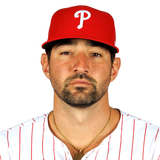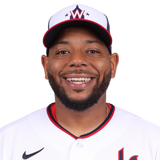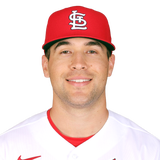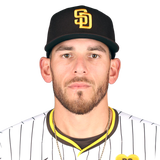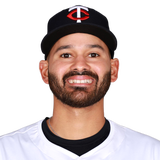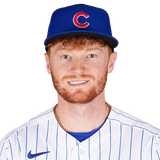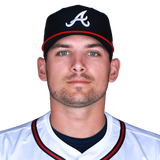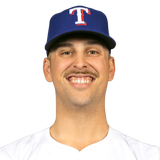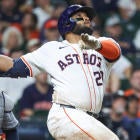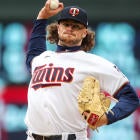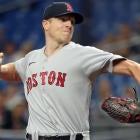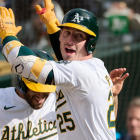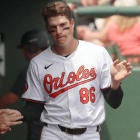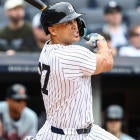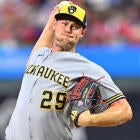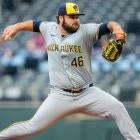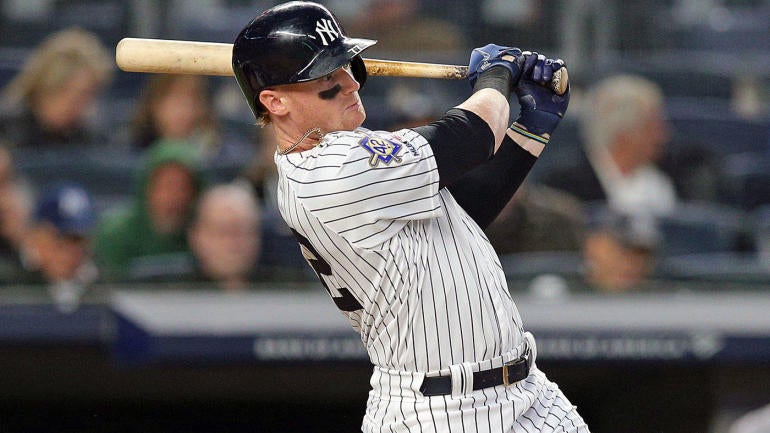
How is a sleeper different than a breakout? I think sleepers have become synonymous with undervalued players. There truly aren't any "sleepers" anymore because most who play Fantasy Baseball know the player pool inside-and-out. Even with that, average draft position or ADP as we call it has these pockets of value. Sometimes there is groupthink on a certain player, which causes them to be undervalued. If enough people have been burned by Carlos Correa in the past, that will cause him to slip down draft boards (more on him when I get to sleepers).
Breakouts are very similar to sleepers except the difference for me is a player's perceived ceiling. Players that I believe can breakout are ones that can either achieve heights we haven't seen before or get back to an elite level they've shown in the past. Maybe I'm expecting a sleeper being drafted at pick 150 to finish as a top-100 player. That's a great profit and a player you should target. But maybe there's a breakout you like being drafted slightly earlier who you think can finish as a top-50. That's the main difference for me. Is it possible your sleeper winds up being a breakout? Sure, that probably just means you're really good at choosing sleepers.
Okay, I'm done confusing you. Here are my top breakout picks for 2021!
Nick Castellanos
| ||||||||||
There are a lot of smart Fantasy Baseball players out there. How do I know? Last year Nick Castellanos' ADP was 91.8. Despite batting just .225 with a .784 OPS in 2020, Castellanos' ADP has actually climbed this year. It hasn't moved a lot as he's up to 88.5 but that shows me that people are paying attention to the underlying numbers. It actually reminds me a lot of what happened with Marcell Ozuna entering last season. While Ozuna batted just .241 with a .472 slugging percentage in 2019, Statcast said he deserved a .291 batting average and a .548 slugging percentage based on the quality of contact he made.
Castellanos posted career-high marks in barrel rate (16%), average exit velocity (91 MPH), and hard-hit rate (46.7%) last season. I mentioned his .225 batting average earlier but Statcast reveals that Castellanos has an expected batting average of .273. This was because he was quite unlucky. Among 23 qualified hitters with a 25% line drive rate or better, Castellanos' .257 BABIP was the lowest. That comes from somebody with a .329 career BABIP. Where Castellanos needs to improve is the strikeouts. He posted a career-worst 28.5% last season but seeing how his strikeout rate was 23% from 2013-2019, I would expect him to bounce-back in that department. I've always said I think Castellanos was capable of a monster season where he hits .280+ with 30+ home runs and 200+ runs and RBI combined. I'm not backing down now.
Dominic Smith
| ||||||||||
Dominic Smith is a monster season waiting to happen. The Mets just need to get out of their own way. I will admit it's not ideal that the team just went out and signed Kevin Pillar after already adding Albert Almora this offseason. However, Anthony DiComo who covers the Mets for MLB.com expects Smith to remain the starter in left field. There are defensive limitations with Smith in the outfield, but I believe his offensive contribution can outweigh the defensive shortcomings. The proof is in the pudding. Since the start of 2019 (139 games), Smith is batting .299 with a .937 OPS.
He took that to another level in 2020. Although it was only 50 games, Smith batted .316 with 10 home runs and 42 RBI. That's a 30-homer, 126-RBI pace over 150 games. Statcast is buying Smith too as he ranked in the 86th percentile or better in barrel rate (13.3%), expected slugging percentage (.568), and expected batting average (.304). And before the Mets even THINK about platooning Smith (because I know they are!), Smith has crushed lefties last two seasons. He posted an .876 OPS against them in 2019 and then a .900 mark in 2020. The price is a bit steep at 107.8 ADP but I will point out he's dropped over the past few weeks. Assuming he gets regular playing time in 2021, I would not be the least bit surprised if we're talking about Smith as top-50 next season.
Dylan Carlson
| ||||||||||
While it wasn't the best debut season for Dylan Carlson, he did show signs of improvement down the stretch. Through Carlson's first 23 games, he was batting just .162 with four extra-base hits and a 31% hard-hit rate. He was then sent back to the alternate training site but would return for the final few weeks. Over his final 12 games, Carlson batted .278 with seven extra-base hits and a 44% hard-hit rate. That tells me he has the wherewithal to adjust, which is something I always like to see from younger players.
Let's not forget Carlson was one of the Cardinals top prospects entering last season. He put together a monster season in the minors in 2019 where he batted .292 with 26 home runs, 20 steals, and a .914 OPS. I also really like his lineup context. The Cardinals aren't the deepest offensive team but the acquisition of Nolan Arenado certainly helps things. Carlson also hit cleanup in each of the Cardinals' three postseason games. As things stand now, Carlson's likely batting fourth or fifth for St. Louis this season, which should produce many RBI and run-scoring opportunities. 20+ home runs with 15+ steals definitely seems doable with the upside for even more if he really gets going.
Joe Musgrove
| ||||||||||
Everybody at some point in time has been burned by Joe Musgrove whether they know it or not. In Breakouts 1.0, I compared my Fantasy relationship with Musgrove to that of Ryan and Kelly in "The Office". If you haven't watched the show, what are you waiting for? The moral of the story is that despite their rocky relationship, Ryan and Kelly always find a way back to each other. That's me and Musgrove. I will admit that pitchers with 4.33 career ERA and a 1.23 WHIP likely doesn't deserve to be drafted inside the top-150 picks. Here's to hoping that we see more of the adjustments he made in September last season with his new team, the San Diego Padres.
Musgrove does this thing every season during the final month where he reminds us of his upside. 2020 was no different. We saw massive improvements in his swing-and-miss ability thanks to increased fastball velocity and more breaking pitches:
| ERA | xFIP | K/9 | BB/9 | SwStr% | FB Velo | CB Usage |
First Three Starts | 6.75 | 5.30 | 10.4 | 6.8 | 11.4% | 91.9 MPH | 17%
|
Final Five Starts | 2.16 | 1.95 | 13.7 | 1.8 | 16.3% | 92.8 MPH | 22% |
No, I'm not expecting anything close to what Musgrove did over these final starts but it's just a friendly reminder of what he's capable of. I'll be paying close attention to Musgrove's velocity throughout spring training. He's always pitched better when his fastball was hovering around 93-94 MPH than the 91-92 we see at times. If Musgrove can stay healthy, I think we see a mid-3s ERA, a sub-1.20 WHIP with over a strikeout per inning.
Pablo Lopez
| ||||||||||
At first glance, it might seem like Pablo Lopez's 132 ADP is a bit high based on what he's accomplished to this point but there is a lot to like here. What instantly stands out to me from Lopez's 2020 was how he changed his pitch mix. He lowered his curveball usage from 19% in 2019 to just 7% in 2020, opting for more changeups and a new cutter he used 8% of the time. The changeup is filthy and one I compared to Luis Castillo lite. The pitch had an O-Swing of 43% last season and a swinging strike rate of 17.8%.
Speaking of swinging strike rate, Lopez improved his overall mark from 10.2% in 2019 to 12.1% last season, better than the league average. He finished his season with a 3.61 ERA with an expected ERA of 3.28 based on Statcast. Also, I know we're not supposed to do this but there are no rules with breakouts! I mentioned Lopez finished with a 3.61 ERA but that includes a blow-up start where he allowed seven earned runs in 1.2 innings against the Atlanta Braves. If you take that start away, Lopez had a 2.61 ERA in his other 10 starts. The pitch-mix change and improvements in generating swings-and-misses have me pretty excited about Lopez this season. I'd be happy to get him as my SP4 or later.
Tyler Mahle
| ||||||||||
Technically Tyler Mahle broke out last season but he's not being treated as such with an ADP of 187.8. That's music to my ears. Mahle was awesome in 2020, pitching to a 3.59 ERA with a 1.15 WHIP. Like Lopez, Statcast tells us Mahle was actually a little unlucky. Based on the quality of contact Mahle allowed, his expected ERA was 3.33. He did this all while striking out 60 over 47.2 innings, good for an exemplary 11.3 K/9. The strikeouts were backed up by a career-high 13.8% swinging strike rate, which would have been better than Trevor Bauer, Aaron Nola, and Brandon Woodruff had he qualified.
If you're wondering how Mahle got this level, it's likely thanks to a pitch-mix change. Like most, he's tinkered quite a bit throughout his career. It seems like he's at his best with the three pitches he relied on most in 2020: his four-seam fastball, slider, split-change. After scrapping his slider for the curveball in 2019, he did the opposite last year, throwing his slider 33% of the time. The fastball and slider make up most of his repertoire while he mixes in that split-change about 12% of the time as a decent third offering. Whatever you do, Mahle, don't go tinkering again like your ex-teammate Trevor Bauer. It seems like Mahle has the recipe for success, he just needs to do it over a full season now. If things break right, I could see a Corbin Burnes-esque impact from Mahle in 2021.
Clint Frazier
| ||||||||||
Cue up the "Frank is a homer!" accusations. There's never been any doubt about Frazier's talent, only his playing time. Through 162 career games, Frazier has 24 home runs with 82 RBI and an .806 OPS. Well on the first day of Yankees camp, Aaron Boone revealed Frazier will be the team's starting left fielder:
Boone said that he sees @clintfrazier as the #Yankees' starting left fielder.
— Bryan Hoch (@BryanHoch) February 17, 2021
"Clint has earned his place."
I already mentioned what Frazier has done in his career and yes, it's a small sample size, but Frazier was at his best in 2020. In the 39 games, Frazier batted .267 with a .905 OPS and a career-high 15.6% walk rate. His 150-game pace came out to 30 home runs, 100 RBI and 11 steals. We'll take that! Frazier has one of the quickest swings in baseball, which helps him generate hard contact. He owns an 11% barrel rate for his career, which is nearly double the league average. The main flaw to Frazier's game has been his struggles against breaking pitches. He's batted .240 or less three straight seasons against breakers (hopefully opposing pitchers aren't reading this). If all breaks right for Frazier, I could see a .270+ batting average with 30 home runs, solid counting stats and a handful of steals. He will strikeout quite a bit but this increased walk rate should help mitigate that in points leagues.
Austin Riley
| ||||||||||
Austin Riley seems to be a popular breakout candidate and rightfully so. We're talking about a former top prospect who has had his ups and downs in the majors but showed steady improvements in 2020. Before we get there, let's remember that Riley hit 16 home runs across his first 48 games back in 2019. The power is legit! However, he would struggle the remainder of his rookie campaign thanks in large part to a massive 36% strikeout rate.
On the surface, Riley's 2020 campaign was mediocre at best. He wound up hitting just .239 with a .716 OPS. The plate discipline took a big step forward, though. Riley improved his walk rate from 5.4% to 7.8% and lowered his strikeouts all the way down to 24%. While it seems like he may have sacrificed power to do so, his 91 MPH average exit velocity in 2020 was actually higher than his 89.4 MPH in 2019. Riley's .415 slugging percentage last season also seems paltry but based on his quality of contact, Statcast expected his slugging percentage to be .471. This one is pretty easy. If Riley just couples his new contact approach with his massive power, we could easily see 30+ home runs with solid counting stats in the Braves' lineup. I've been targeting Riley as a late-round corner infielder in Roto or as a bench bat with upside in H2H points leagues.
Dane Dunning
| ||||||||||
The Rangers traded Lance Lynn to the White Sox this offseason for a package headlined by 26-year old starting pitcher Dane Dunning. They clearly like him and you should too. If you just look at his numbers at face value, Dunning was very solid in his first major-league stint. He finished with a 3.97 ERA and a 1.12 WHIP, striking out 35 across 34 innings pitched. Oddly enough, his first three starts were loaded with swinging strikes while his final four were not as fruitful. Did something change?
| Swinging Strike Rate | Slider Usage |
First Three Starts | 17.5% | 28% |
Final Four Starts | 6.9% | 17% |
For some reason, Dunning stopped using his slider as much. Perhaps it was the White Sox trying to get him to pitch to contact so he can go deeper into starts? Whatever the reason, he should get back to using the slider. The pitch generated a 38% chase rate with a 22% swinging strike rate last season. Dunning is older for a prospect but he had Tommy John surgery in 2019. He comes equipped with fantastic minor league numbers: 2.74 ERA with 300 K across 266 innings. He'll be in the Rangers Opening Day rotation and is somebody I'm drafting on the bench of all my teams.
Nate Lowe
| ||||||||||
Let's stick with my new favorite American League team (behind the Yankees and White Sox, of course). The Texas Rangers won my heart when they freed Nate Lowe from the shackles that are the Tampa Bay Rays. Who knows, maybe the Rays are just smarter than everybody else. That's usually the case but I refuse to believe it with Lowe. He hit just .224 in 21 games last season but did flash some pop with four home runs. Statcast shows us some interesting things as well. Lowe had a max exit velocity of 114.8 MPH, which was 19th in baseball last season. Studies have shown that max exit velocity does correlate well with in-game power.
The real reason you want Lowe is because he was a stud in the minors. Back in 2018, Lowe put up a massive .330 batting average with 27 home runs across 130 games. The next season he followed that up with a .289 batting average and 16 home runs in 93 games. All the while, he was crushing left-handed pitching. Across both 2018 and 2019 in the minors, Lowe never had an OPS below .819 against lefties. That gives me confidence that he should at least be adequate against them in the majors and (hopefully) he won't be used as a platoon. I think his 90th percentile outcome could be a .280+ batting average with 30 home runs and 180 runs plus RBI combined. Draft him as a late-round flier or keep him on your watch list early in the season.
So which 2021 Fantasy baseball sleepers should you snatch in your draft? And which undervalued first baseman can help you win a championship? Visit SportsLine now to get Fantasy baseball rankings for every single position, all from the model that called Will Smith's huge breakout last season, and find out.








